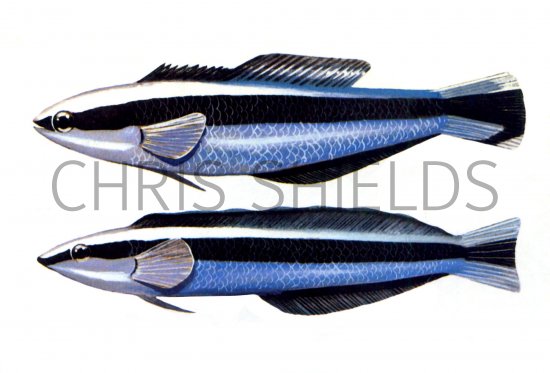photo from http://goo.gl/4KEih6,上為醫生魚,下為假醫生魚
原文標題:Geographical variation in the benefits obtained by a coral reef fish mimic
Mimicry systems are frequently categorized by the type of benefit gained by the mimic's resemblance to its model: protection from threat, including predation (protective mimicry), and increased access to resources, including prey items (aggressive mimicry). These category types may not be mutually exclusive, and some mimics may gain more than one type of benefit. Here we examined a contentious classic textbook example of mimicry between the cleaner wrasse Labroides dimidiatus and its mimic, the sabre-toothed blennyAspidontus taeniatus. We found that the benefit obtained by the sabre-toothed blenny varied between four geographical locations. At the Great Barrier Reef, in Indonesia and in the Red Sea, it rarely attacked reef fish victims, but instead relied on other food sources such as substrate items, damselfish eggs and tubeworms. Here, the main function of the mimicry system could be to protect the sabre-toothed blenny from predation (protective mimicry) and was consistent with a previous study in Japan. However, in French Polynesia, the sabre-toothed blenny aggressively attacked reef fish frequently, and potential victims were more likely to pose to solicit a cleaning interaction. Diet analysis from individuals in French Polynesia indicated material was gleaned from the surface of fish, including large pieces of fin, implying an increase in the benefits obtained from attacking reef fish (aggressive mimicry). This study provides a potential second example of a mimicry system in which multiple types of benefits are gained by a mimic, and importantly, that the benefits obtained by the mimic vary between different environmental conditions and/or geographical locations. This may have important implications for the maintenance and evolution of mimicry systems and may reflect different stages of an arms race with potential victims.
裂唇魚(醫生魚)與三帶盾齒䲁(假醫生魚)是一個極為經典的侵略型擬態(aggresive mimicry)的例子,以往介紹這個例子的時候,都會說到假醫生魚藉由擬態醫生魚靠近他的換「患者」,然後偷咬別人的肉得到好處,但是這個故事已經不是那麼簡單了。
近年來有些證據顯示,擬態斑紋的作用或許不只一個,或是擬態的對象不是單純的一對一,可能是一個中間型像多個擬態的對象。這篇研究討論假醫生魚的擬態現象,主要是跟著1983年日本的關於假醫生魚的一個研究,再進一步擴大討論,作者探索了幾個不同的海域,發現假醫生魚的擬態可能有多種功能:在大堡礁、印尼與紅海區域,假醫生魚可躲過掠食性魚類的攻擊,而且鮮少攻擊其他魚類,這個益處來自醫生魚不會被某些掠食性魚類攻擊(即為保護性擬態),這個部分的結果與日本的嚴就是一致的;而在法屬波里尼西亞海域,假醫生魚則透過侵略型擬態的關係得到較多的好處。最重要結果告訴我們同一個擬態群在不同的時空與環境下,可能會有不一樣的運作模式。
這篇文章基本上該做的都做了:他們是在野外做的(每天要潛水8hr以上觀察)而非實驗室內操作;確認被攻擊的種類與掠食的種類;同時他們也比較了一些變因(移除某些或保留某些魚類觀察行為變化),是一篇滿完整的研究。
雖然近幾年有文章指出這些事情(一個擬態斑紋有多model/多作用),可是研究的類群分布廣泛,而且相對來說證據薄弱文章數量較少,目前尚無法看出是否有某些通則。






0 comments